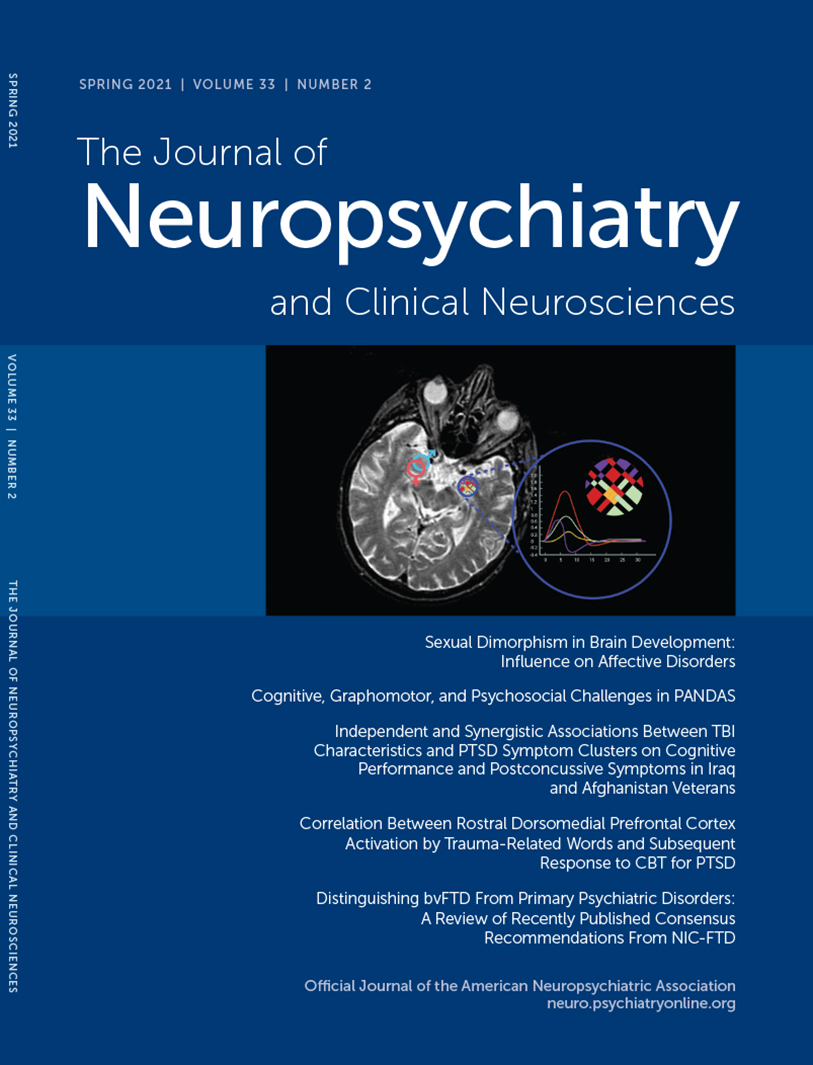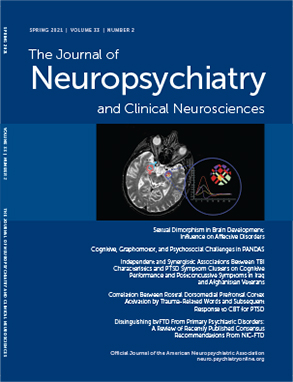Pediatric autoimmune neuropsychiatric disorders associated with streptococcal infections (PANDAS) is characterized by the rapid onset of obsessive-compulsive disorder (OCD) in the days to weeks following a streptococcal infection (
1). Frequently, additional neuropsychiatric symptoms also emerge, including attentional difficulties, mood disruption, motor or vocal tics (
2), and other behavioral changes (e.g., a decline in handwriting, nocturnal enuresis) (
3,
4). Symptoms often improve as the acute phase of the illness resolves but may persist without treatment or with recurrent group A streptococcal infections. Preliminary studies using antibiotics (
5) and anti-inflammatory therapies (
6–
8) have shown efficacy in patients with PANDAS, although a mechanistic link between inflammation and neuropsychiatric symptoms in PANDAS has yet to be conclusively demonstrated.
Multiple convergent lines of evidence suggest that OCD and tic symptoms are related to dysfunction in a series of neuronal networks connecting the basal ganglia, thalamus, and cerebral cortex, termed the cortico-striato-thalamo-cortical circuit (
9–
13). The OCD and tic symptoms of PANDAS, specifically, are hypothesized to result from either an autoimmune or inflammatory disruption of cortico-striato-thalamo-cortical circuits. Recent studies have shown structural and functional neuroimaging abnormalities in the basal ganglia; antibodies isolated from children with PANDAS, compared with control subjects, selectively recognize a subtype of neuron in the basal ganglia of postmortem human brain (
14–
18). If PANDAS symptoms reflect selective involvement of these networks, as the autoimmune antibody data suggest, then patients with PANDAS may exhibit a distinct neuropsychological profile of vulnerability within cognitive, affective, or behavioral domains (
19–
22). Specifically, weaknesses in aspects of executive function related to cognitive efficiency may follow disruption of basal ganglia networks, including inattention, cognitive slowing (slow processing speed), reduced verbal initiation, difficulties with set-shifting, disinhibition, and reduced working memory (
22–
25). Affective changes may include mood dysregulation, ranging from anhedonia to mania and psychosis (
22,
26,
27). Behavioral changes may include motor impairment, including difficulties with fine motor coordination and precision (
22,
28).
Neuropsychological profiles of patients with PANDAS have not been extensively studied; accordingly, we present comprehensive findings from a well-characterized cohort of PANDAS patients who completed clinical neuropsychological evaluations. Previous studies of cognitive functioning in patients with PANDAS have found reduced performance on a visual memory test (
29), reduced sustained attention and response suppression (
30), and reduced processing speed (
31). We aimed to extend this research and specifically examined whether skills associated with frontostriatal networks, namely graphomotor skill and executive functions associated with cognitive efficiency, are selectively impaired in a clinical sample of patients with PANDAS. Measures of academic achievement are also reported, including academic fluency and writing, which require the integration of executive function and motor skills. Parent-reported psychosocial functioning is also described, in addition to behavioral and emotional functioning.
Discussion
We reported the clinical characteristics and neuropsychological profiles in a clinical sample of pediatric patients diagnosed with PANDAS. To date and to our knowledge, this is the most comprehensive analysis of neuropsychological performance in a cohort of patients with PANDAS. Overall intellectual functioning fell in the average range (WISC-V GAI: z=0.34, SS=105, 63rd percentile). Relative to their intellectual aptitude, PANDAS patients exhibited weaknesses in cognitive and motor skills. Specifically, patients with PANDAS had greater difficulty sustaining attention, inhibiting responses to stimuli, and quickly integrating and acting upon new information (i.e., exhibited slower processing speed). These findings are consistent with prior studies (
30,
31). Parents also endorsed significant inattention and hyperactivity, as well as difficulties applying aspects of executive functions to solve problems (metacognition) and regulate behavior; however, relatively few patients were treated with stimulant medication (N=4, 15%). The degree of difficulty on formal testing was relatively mild; significant scores on measures of cognitive functioning and parent-reported challenges generally fell within one standard deviation of the normative data mean, which is similar to the degree of difficulty reported previously (
29). From a diagnostic perspective, the nature of these difficulties overlaps with what is typically associated with ADHD, which is perhaps not surprising given high comorbidity between ADHD and pediatric-onset OCD (
43).
Regarding motor skills, nearly all patients (N=25, 93%) were right-handed and dexterity was within age-based expectations bilaterally. However, 70% (N=19) of parents reported writing difficulties in their children, consistent with prior findings that handwriting difficulties are commonly reported in patients with PANDAS (
3). On formal testing, patients had greater difficulty than the age-matched normative sample on a graphomotor precision measure requiring them to draw increasingly complex geometric figures (Beery-Buktenica Visual-Motor Integration–Sixth Edition). Lewin et al. (
29) also found that patients with PANDAS had difficulty copying a complex figure despite age-appropriate dexterity. Of note, there were also reported difficulties in freely recalling the same figure after a delay, leading to the conclusion that nonverbal memory may be compromised in patients with PANDAS. Given our finding that verbal and nonverbal intellectual abilities are evenly developed, we suggest an alternative explanation of these findings. Specifically, reduced graphomotor control and difficulties with attentional regulation may be core clinical features of PANDAS; combined, they contribute to reduced initial learning of drawn or copied information, which would also manifest as lower delayed recall scores.
Academic difficulties were frequently reported by parents. Nearly all patients (93%) had some academic concerns, and more than half of the sample (63%) was receiving special education services or accommodations (individualized education program or 504 Plan) at the time of the neuropsychological evaluation. Although we did not always have access to school records to confirm when special education services were initiated, given that some patients received early intervention services, it is likely that some patients also received special education services prior to the onset of their neuropsychiatric symptoms. Writing was identified as an area of particular difficulty; 67% of parents reported writing difficulties. This perhaps reflects written expression’s combined demands on graphomotor control and executive functions (e.g., the retrieval and organization of ideas). Performances on formal measures of written expression were within normal limits, but standard scoring did not allow for assessment of the different aspects of writing (e.g., grammar, organization of ideas), and patients had strong verbal skills.
Parents also reported math and reading difficulties in approximately half of the sample (56% each). Yet on formal academic achievement testing, core decoding (reading), spelling, and arithmetic skills were within normal limits, which is consistent with previous findings (
29). However, scores on measures of reading and math fluency were significantly below aptitude-based expectations, although still within one standard deviation of the normative mean. In the absence of primary difficulties with reading and math, weaker academic fluency may reflect the functional impact of slower processing speed and difficulties with attentional regulation. Although rates of academic difficulties may be higher in this clinical sample due to selection bias (i.e., patients with academic difficulties may be more likely to be referred for neuropsychological evaluation), the current results suggest that weaknesses in executive functions and motor skills may interfere with academic functioning, such that it should be assessed as part of routine clinical care in children diagnosed with PANDAS.
Finally, there were significant and chronic emotional and social concerns, even though only half (56%) of the sample were reportedly exhibiting OCD symptoms at the time of evaluation and evaluations were, on average, typically completed approximately 2 years after initial symptom onset. On standardized questionnaires, parents endorsed heightened symptoms of anxiety and depression, as well as difficulties with social communication. Social communication concerns were relatively mild, as no patients were diagnosed with autism spectrum disorder, which also suggests that these may be secondary to psychiatric symptoms. On the basis of parent report, generalized worries (37%), separation anxiety (43%), and explosive episodes (44%) were the most common ongoing concerns. Although difficulties were reportedly mild at the time of neuropsychological testing (scores on standardized questionnaires were largely within one standard deviation of the normative mean), higher risk of severe emotional difficulties has been previously reported in PANDAS patients (
44). Indeed, in the current sample, 26% had experienced past suicidal ideation, 7% had experienced past psychotic symptoms, and 11% had a prior psychiatric hospitalization. Additionally, at the time of evaluation, approximately half (56%) were taking psychiatric medication or engaged in psychotherapy (56%). More than half (67%) were being treated with antibiotic medication. These data underscore the importance of ongoing psychiatric services as a component of treatment for PANDAS, even with the relapsing and remitting course (
45).
These findings raise multiple questions for future research, including the degree to which neuropsychological profiles correlate with biomarkers of immune dysregulation and neuropsychiatric symptom severity. Given that these were clinical neuropsychological evaluations, laboratory data were not obtained simultaneously with neuropsychological evaluation. It is clear that prospective, longitudinal studies of PANDAS patients documenting cognitive, motor, and psychiatric function in relation to concurrent infections are needed. Lewin et al. (
29) found that PANDAS children with elevated strep (antistreptolysin O) titers had greater difficulty with graphomotor function, inhibitory control, and dexterity, as well as greater OCD symptoms, suggesting that these weaknesses may be exacerbated during relapses. Our results also suggest that it will be important for future studies to carefully characterize developmental histories, including psychiatric and learning histories, prior to the first PANDAS episode. On the basis of parent report, approximately one-third of patients had a history of prematurity or perinatal complications, and 40% reported mild developmental delays, perinatal complications, and developmental delays. These findings suggest that there may be a measure of neurobiological vulnerability that increases susceptibility to PANDAS and also raise the question about whether weaknesses in neuropsychological skills existed prior to the onset of PANDAS symptoms. Serial monitoring of neuropsychological functioning in PANDAS patients over the course of development will also be important in determining the degree to which fluctuations in markers of immune dysfunction and neuropsychiatric symptoms are associated with changes in cognitive and motor skills. Such studies will allow tracking of symptom severity over time to determine whether symptom severity at diagnosis or during the worst episode correlates with cognitive or motor difficulties.
Finally, additional research is needed to determine the variability, if any, in neuropsychological profiles of patients with PANDAS compared with other pediatric-onset disorders associated with frontostriatal dysfunction, specifically ADHD, Tourette’s syndrome, and OCD (
21,
30). Patients in the present study had high rates of clinical symptoms characteristic of these disorders, including OCD symptoms, inattention, hyperactivity, and tics (70%), which is consistent with prior studies of PANDAS patients (
46). The neuropsychological weaknesses identified in the present study also highly overlap with those reported in these populations (
11,
21,
47–
49), suggesting that additional biomarkers in combination with neuropsychological performance may be useful in differentiating PANDAS from these related conditions. However, our study demonstrates that neuropsychological assessment is an important step in fully characterizing the complexity of PANDAS patients’ cognitive, academic, and emotional needs, and these findings underscore the importance of neuropsychological evaluation in the care of children with PANDAS.
This study provides a comprehensive perspective on neuropsychological functioning within a clinical sample of patients with PANDAS. On neuropsychological measures, patients exhibited average intellectual functioning with relative and mild weaknesses in attentional regulation, aspects of executive function, and graphomotor skill. Likely reflecting the cumulative effect of these weaknesses, performances on measures of academic fluency were also weak. Parents reported high levels of concern about anxiety, depression, inattention, hyperactivity, and social skills, even well beyond initial symptom onset, as well as the need for special education supports. These findings open multiple avenues for future research and highlight the need for ongoing psychiatric services and academic supports in PANDAS patients.

